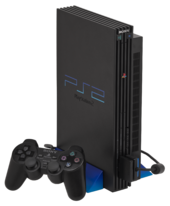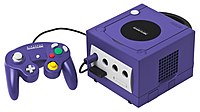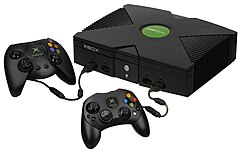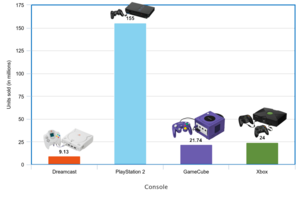
A | B | C | D | E | F | G | H | CH | I | J | K | L | M | N | O | P | Q | R | S | T | U | V | W | X | Y | Z | 0 | 1 | 2 | 3 | 4 | 5 | 6 | 7 | 8 | 9
| Part of a series on the |
| History of video games |
|---|
In the history of video games, the sixth generation era (in rare occasions called the 128-bit era; see "bits and system power" below) is the era of computer and video games, video game consoles, and handheld gaming devices available at the turn of the 21st century, starting on November 27, 1998. Platforms in the sixth generation include consoles from four companies: the Sega Dreamcast (DC), Sony PlayStation 2 (PS2), Nintendo GameCube (GC), and Microsoft Xbox. This era began on November 27, 1998, with the Japanese release of the Dreamcast, which was joined by the PlayStation 2 on March 4, 2000, the GameCube on September 14, 2001 and the Xbox on November 15, 2001, respectively. On March 31, 2001, the Dreamcast was among the first to be discontinued. Xbox in 2006, GameCube in 2007 and PlayStation 2 was the last, in January 2013. Meanwhile, the seventh generation of consoles started on November 22, 2005, with the launch of the Xbox 360.[1]
The major innovation of this generation was of full utilization of the internet to allow a fully online gaming experience. While the prior generation had some systems with internet connectivity, such as the Apple Pippin, these had little market penetration and thus had limited success in the area. Services such as Microsoft's Xbox Live became industry standard in this, and future, generations. Other innovations of the Xbox was its being the first system with an internal ethernet port and the first to utilize an internal hard disk drive to store game data. This led to many improvements to the gaming experience, including the ability to store program data (rather than just save game data) that allowed for faster load times, as well as the ability to download games directly from the internet rather than to purchase physical media such as a disk or cartridge. Soon after its release other systems, like the Sony PlayStation 2, produced peripheral storage devices to allow similar capabilities, and by the next generation internal storage became industry standard.
Bit ratings (i.e. "64-bit" or "32-bit" for the previous generation) for most consoles largely fell by the wayside during this era, with the notable exceptions being promotions for the Dreamcast[2] and PS2[3] that advertised "128-bit graphics" at the start of the generation. The number of "bits" cited in this way in console names refers to the CPU word size, and had been used by hardware marketing departments as a "show of power" for many years. However, there is little to be gained from increasing the word size much beyond 32 or 64 bits because, once this level is reached, performance depends on more varied factors, such as processor clock speed, bandwidth, and memory size.[citation needed]
The sixth generation of handhelds began with the release of the Bandai's WonderSwan, launched in Japan in 1999. Nintendo maintained its dominant share of the handheld market with the release in 2001 of the Game Boy Advance, which featured many upgrades and new features over the Game Boy. The Game Boy Advance was discontinued in early 2010. The next generation of handheld consoles began in November 2004, with the North American introduction of the Nintendo DS.
The last official Dreamcast games were released in 2002 (North America and Europe) and 2007 (Japan). The last GameCube games were released in 2006 (Japan) and 2007 (North America and Europe). The last Xbox games were released in 2007 (Japan) and 2008 (Europe and North America). Pro Evolution Soccer 2014 was the last game for the PlayStation 2 (in Europe), which was released in November 2013.[4] The last PS2 game, Final Fantasy XI: Rhapsodies of Vana'diel, was released in May 2015, marking the end of this generation.[5]
Home systems

The Sony PlayStation 2[6][7][8] achieved sales dominance in this generation, becoming the best-selling console in history,[9] with over 150 million units sold as of February 2011.[10] The Microsoft Xbox had sold over 24 million units as of May 2006,[11][12] and the GameCube had sold 22 million units as of September 2010.[13] The Sega Dreamcast, which arrived prior to all of the others and was discontinued in 2001, came in fourth with 9.13 million sold.[14]
The sixth generation began to end when the Xbox was succeeded by the Xbox 360 in late 2005. GameCube hardware was still being produced when the Wii was released in late 2006, but as of June 2008 had also been ceased. PlayStation 2 sales continued to be strong through to the end of 2010,[15] due to the system's large software library, continuing software support, and affordable price.[16]
In February 2008, the PlayStation 2 outsold both the PlayStation 3 and Xbox 360 in the United States.[17][18] Games were still being produced for the PlayStation 2, Xbox, and GameCube as of 2008, while Dreamcast games were officially discontinued in 2003. There were still a few games being produced for the Dreamcast in 2004, but they are essentially NAOMI arcade ports released only in Japan, with small print runs. The PlayStation 2 was still being produced after the launch of the Wii U in 2012, making the sixth generation the second longest generation of all time.
Dreamcast
Sega's Dreamcast is the first console of the generation[19] and had several features to show an advantage from the competition, including Internet gaming as an optional feature through its built-in modem, and a web browser.
The console is credited with restoring Sega's reputation,[20] which had been damaged by the earlier failures of the Sega Saturn, Sega 32X, Genesis Nomad and Sega CD.[21] Despite this, the Dreamcast was discontinued prematurely due to numerous factors. The impending and much-hyped PlayStation 2 slowed Dreamcast sales, mostly due to the fact that the PlayStation 2 had a built-in DVD player and a huge number of PS1 owners looking to upgrade to the new, backward compatible console.[22] In addition, Sega's short-lived support/success of its post-Mega Drive products the Mega-CD, 32X and Saturn had left developers and customers skeptical, with some holding out to see whether the Dreamcast or PlayStation 2 would come out on top.[23]
Sega's decision to implement a GD-ROM (though publicly advertised as a CD-ROM) for storage medium did save costs but it did not compare well against the PS2's much-touted DVD capabilities. Sega was either unable or unwilling to spend the advertising money necessary to compete with Sony, who themselves took massive losses on the PlayStation 2 to gain market share. With the announcements of the Xbox and GameCube in late 2000, Sega's console was considered by some to be outdated only two years after its release. The previous losses from the Saturn, 32X, and Sega/Mega-CD, stagnation of sales due to the PlayStation 2, and impending competition from Microsoft and Nintendo caused Sega's revenue to shrink and announce their intention on killing the system in early 2001,[24] dropping the system entirely and leaving the console market in early 2004 in Japan and much earlier in other countries. Sega also announced it would shut down SegaNet, an online gaming community that supported online-capable Dreamcast titles. Due to user outcry over the decision, Sega delayed the service's closure by an additional 6 months.[24] Since the Dreamcast's discontinuation, Sega transitioned to software developing making games as a third-party company.
PlayStation 2
The brand Sony had established with the original PlayStation was a major factor in the PlayStation 2's dominance, both in terms of securing a consumer base and attracting third-party developers, with the gradual increase in one reinforcing the other. The PlayStation 2 was also able to play DVDs and was backward compatible with PlayStation games, which many say helped the former's sales.[25] Sony Computer Entertainment secured licensing for key games such as Final Fantasy X, Grand Theft Auto III, and Metal Gear Solid 2: Sons of Liberty, enabling the PS2 to outperform its competitors' launches. The console ended up becoming the top-selling console of this generation, while its competing consoles, the Xbox and the GameCube, went on to be modestly successful consoles.[26][27]
GameCube
Nintendo struggled with conflicting brand images, particularly the family-friendly one developed during the 1990s. Its arsenal of franchises and history in the industry, though earning it a loyal fan base, failed to give it an advantage against the Xbox and PlayStation 2 which captured audiences seeking 'Mature' titles of which Nintendo had fewer. Nintendo also made little headway into online gaming (releasing a small handful of online-capable games, the most popular of which was Phantasy Star Online Episode I and II, which was an enhanced port of the Dreamcast game with various new features and content), instead emphasizing Game Boy Advance connectivity. As a result, the GameCube failed to match the sales of its predecessor, the Nintendo 64, but the console wasn't a financial failure. Nintendo did however rejuvenate its relationship with many developers,[28] often working in close collaboration with them to produce games based upon its franchises, in contrast to the past where it was frequently seen as bullying developers in the late 1980s, back when the Nintendo Entertainment System was out on the market. As a result, the GameCube had more first and second party releases than its competitors,[28] whose most successful titles were mainly products of third-party developers.[28]
Xbox
Although the Xbox had the formidable financial backing of Microsoft, it was unable to significantly threaten the dominance of the PlayStation 2 as market leader.[29] However, the Xbox attracted a large fanbase and strong third-party support in the United States and Europe and became a recognizable brand amongst the mainstream. The Xbox Live online service with its centralized model proved particularly successful, prompting Sony to boost the online capabilities of the PlayStation 2. Xbox Live also gave the Xbox an edge over the GameCube, which had a near-total lack of online games. The flagship of Xbox Live was the game Halo 2, which was the best-selling Xbox game with over 8 million copies sold worldwide.[30][31] However, the Xbox failed to gain a following in Japan, with reasons cited including lack of brand recognition, lack of commitment to the console from Japanese publishers and developers, failure of Microsoft staff to fully understand important cultural differences, and ethnocentric preferences of the Japanese public for native products.[32][33]
Comparison
| Name | Dreamcast | PlayStation 2 | GameCube | Xbox | |
|---|---|---|---|---|---|
| Logo |  |
||||
| Manufacturer | Sega | Sony (SCE) | Nintendo | Microsoft | |
| Image(s) | 
|

|

|

| |
| An NTSC-U Dreamcast console, controller and VMU. On PAL consoles, the Dreamcast swirl was blue, and on NTSC-J it was red, but on games the swirl often appeared orange. | Left: An original model PlayStation 2 Right: A slimline PlayStation 2 with DualShock 2 controller and memory card. |
An indigo GameCube and controller | An Xbox console and its controllers | ||
| Release date | |||||
| Launch prices | US$ | US$199.99 (equivalent to $370 in 2023)[34] | US$299.99 (equivalent to $530 in 2023) | US$199.99 (equivalent to $340 in 2023) | US$299.99 (equivalent to $520 in 2023) |
| € | DEM499.99 (Equivalent to €255.64 in 1999 or €420 in 2023) | DEM869.99[35] (Equivalent to €444.31 in 2000 or €720 in 2023) | €199.99 (equivalent to €320 in 2023)[36] | €479.99 (Changed to €399.99 shortly before Launch and equivalent to €620 in 2023) | |
| GBP | £199.99 (equivalent to £440 in 2023)[34] | £299.99 (equivalent to £660 in 2023) | £129.99 (equivalent to £270 in 2023)[36] | £299.99 (equivalent to £620 in 2023) | |
| A$ | |||||
| JP¥ | ¥29,000 (equivalent to ¥29,390 in 2019) | ¥39,800 (equivalent to ¥40,730 in 2019) | |||
| Discontinued |
|
Q3 2007[40] | |||
| Media | Type | GD-ROM, CD | DVD, CD | GameCube Game Disc, DVD (Panasonic Q) | DVD, CD |
| Regional lockout | Region locked | Region locked | Region locked | Region locked | |
| Backward compatibility | None | PlayStation | Game Boy family (Game Boy Player required) |
None | |
| Best-selling game | Sonic Adventure, 2.5 million (as of June 2006)[43] | Grand Theft Auto: San Andreas, 20.81 million (as of August 24, 2013) | Super Smash Bros. Melee, 7.5 million (as of August 24, 2013) | Halo 2, 8.49 million (as of August 24, 2013) | |
| Accessories (retail) |
|
||||
| CPU | 200 MHz SuperH SH-4 | 294 MHz MIPS "Emotion Engine" 299 MHz later models | 485 MHz PowerPC "Gekko" | 733 MHz x86 Intel Celeron/Pentium III Custom Hybrid | |
| GPU | 100 MHz NEC/VideoLogic PowerVR CLX2 "Holly" | 147 MHz "Graphics Synthesizer" | 162 MHz ATI "Flipper" | 233 MHz Custom Nvidia NV2A | |
| RAM | Main RAM 16 MB SDRAM Video RAM 8 MB Sound RAM 2 MB |
Main RAM 32 MB dual-channel, RDRAM Video RAM 4 MB eDRAM Sound RAM 2 MB |
Main RAM 24 MB 1T-SRAM, Video RAM 16 MB DRAM 3 MB embedded 1T-SRAM |
64 MB unified DDR SDRAM | |
| Audio | Stereo audio, with:
|
5.1 Surround sound audio, with:
|
Stereo audio, with:
|
5.1 Surround sound audio, with:
| |
| Video outputs | VGA (RGBHV), SCART (RGBS), S-Video, composite | Component (YPBPR, RGsB), VGA (RGsB; progressive scan games/PS2 Linux only), SCART (RGBS), S-Video, composite | Component (YCBCR), SCART (RGBS; PAL consoles only), S-Video (NTSC consoles only), composite | Component (YPBPR), SCART (RGBS), S-Video, composite | |
| Online service | JP: Dricas (1998-2007) NA: Sega Net (2000–2002) EU: Dreamarena (2000–2003) |
Non-unified services (2002–2016) | Non-unified services (2003–2009) | Xbox Live (2002–2010) | |
| System software | Proprietary OS | Proprietary OS, PS2 Linux | Proprietary OS | Proprietary OS | |
Worldwide sales standings

| Console | Units sold |
|---|---|
| PlayStation 2 | 155 million (as of March 31, 2012)[44][45] |
| Xbox | 24 million (as of May 10, 2006)[11][12] |
| GameCube | 21.74 million (as of September 30, 2010)[13] |
| Dreamcast | 9.13 million (as of September 6, 2002)[14] |
Other consoles
These consoles were created for the mass market, like the 4 consoles listed above. However, they are less often noted, never saw a worldwide release, and/or have sold fewer units overall, and are therefore listed as 'Other'.
-
The Nuon was a hybrid DVD player/gaming system released in 2000, that had a very small game library.
-
Panasonic Q, a DVD player hybrid version of the GameCube. Released by Panasonic in 2001.
-
The XaviX is the video gaming base console for the XaviX Interactive System, released by SSD Company Limited in 2004.
Bits and system power
Bit ratings for consoles largely fell by the wayside after the fifth generation (32/64-bit) era. The number of "bits" cited in console names referred to the CPU word size, but there was little to be gained from increasing the word size much beyond 32 bits; performance depended on other factors, such as central processing unit speed, graphics processing unit speed, channel capacity, data storage size, and memory speed, latency, and size.
The importance of the number of bits in the modern console gaming market has thus decreased due to the use of components that process data in varying word sizes. Previously, console manufacturers advertised the "n-bit talk" to overemphasize the hardware capabilities of their system. The Dreamcast and the PlayStation 2 were the last systems to use the term "128-bit" in their marketing to describe their capability.
It is not easy to compare the relative "power" of the different systems. Having a larger CPU word size does not necessarily make one console more powerful than another. Likewise, the operating frequency (clock rate, measured in terms of Hertz) of a system's CPU is not an accurate measure of performance either, except between systems of the same or similar architecture.
The Microsoft Xbox uses a 32-bit (general purpose) CISC x86 architecture CPU, with an instruction set equal to that of the Coppermine core Mobile Celeron, though it has less cache (128 kB) than the PC equivalent. It has 64 MB RAM (shared) and runs at 733 MHz. Because the Pentium 3 introduced SSE, the Xbox also had 128-bit SIMD capabilities. Its NV2A GPU, which is very similar to the GeForce 3 series of desktop GPUs, makes it the only console in its time with traditional vertex and pixel shaders.[46]
The GameCube's CPU is a PowerPC CPU codenamed Gekko that runs at 485 MHz and was built by IBM. Its graphics processor, codenamed "Flipper", is comparable to the original ATI Radeon. The console has 43 MB of non-unified memory (24 MB of 1T-SRAM, 3 MB embedded 1T-SRAM, and 16 MB DRAM).[47]
The PlayStation 2's CPU (known as the "128-bit Emotion Engine") has a 64-bit core with a 32-bit FPU. Coupled to two 128-bit Vector Units, this hybrid R5900 CPU is based on MIPS architecture. The PS2 also has an internal 10 Channel DMA Bus which is fully 128 bits wide. Paths between the Emotion Engine, RAM and the Graphics Synthesizer (GS) are also 128 bits wide. The PS2's unique hardware arrangement with no less than 10 processing units were difficult to come to grips with. Many developers struggled initially with programming the hardware. The PS2's Graphics Synthesizer (GS) has fast dedicated video memory, though it is limited in the amount of data it can hold. The 10 Channel 128 bit wide DMA bus could pump data to GS Memory as fast as the screen could update. Consequently, with the main memory being limited to 32MB, many of the PS2's games have reduced textures compared with versions for other consoles. It also does not have a hardware dedicated transform and lighting unit like the ones found in the Xbox and GameCube GPUs.
However the PS2's design allows a remarkable degree of flexibility and choice. For example, program control and general arithmetic could be handled by the CPU, while the Vector Units 0 and 1, could provide parallel processing of physics, clipping and transform and lighting to the scene. The Vector units were noted to be so versatile that Shadow of The Colossus used one of the vector units to do full Pixel shading for the fur of the Collossi.
The Dreamcast has a 64-bit double-precision superscalar SuperH-4 RISC Central processing unit core with a 32-bit integer unit using 16-bit fixed-length instructions, a 64-bit data bus allowing a variable width of either 8, 16, 32 or 64-bits, and a 128-bit floating-point bus.[48] The PowerVR 2DC CLX2 chipset uses a unique method of rendering a 3D scene called Tile Based Deferred Rendering (TBDR): while storing polygons in triangle strip format in memory, the display is split into tiles associated with a list of visibly overlapping triangles onto which, using a process similar to ray tracing, rays are cast and a pixel is rendered from the triangle closest to the camera. After calculating the depths associated with each polygon for one tile row in 1 cycle, the whole tile is flushed to video memory before passing on to render the next tile. Once all information has been collated for the current frame, the tiles are rendered in turn to produce the final image.
Handheld systems

During the sixth generation era, the handheld game console market expanded with the introduction of new devices from many different manufacturers. Nintendo maintained its dominant share of the handheld market with the release in 2001 of the Game Boy Advance, which featured many upgrades and new features over the Game Boy. Two redesigns of this system followed, the Game Boy Advance SP in 2003 and the Game Boy Micro in 2005. Also introduced was the Bandai's WonderSwan, launched in Japan in 1999. South Korean company Game Park introduced its GP32 handheld in 2001, and with it came the dawn of open source handheld consoles. The Game Boy Advance line of handhelds has sold 81.51 million units worldwide as of September 30, 2010.[13]
A major new addition to the market was the trend for corporations to include a large number of "non-gaming" features into their handheld consoles, including cell phones, MP3 players, portable movie players, and PDA-like features. The handheld that started this trend was Nokia's N-Gage, which was released in 2003 and doubled primarily as a mobile phone. It went through a redesign in 2004 and was renamed the N-Gage QD. A second handheld, the Zodiac from Tapwave, was released in 2004; based on the Palm OS, it offered specialized gaming-oriented video and sound capabilities, but it had an unwieldy development kit due to the underlying Palm OS foundation.
A fairly uncommon handheld of the 6th generation was the vtech V.SMILE Pocket. A handheld version of their V.SMILE home console.
With more and more PDAs arriving during the previous generation, the difference between consumer electronics and traditional computing began to blur and cheap console technology grew as a result. It was said of PDAs that they were "the computers of handheld gaming" because of their multi-purpose capabilities and the increasingly powerful computer hardware that resided within them. This capability existed to move gaming beyond the last generation's 16-bit limitations; however, PDAs were still geared towards the typical businessman, and lacked new, affordable software franchises to compete with dedicated handheld gaming consoles.
Handheld comparison
| Product Line | WonderSwan | Game Boy Advance | N-Gage | ||||||
|---|---|---|---|---|---|---|---|---|---|
| Name | WonderSwan | WonderSwan Color | SwanCrystal | Game Boy Advance | Game Boy Advance SP | Game Boy Micro | N-Gage | N-Gage QD | |
| Logo | |||||||||
| Manufacturer | Bandai | Nintendo | Nokia | ||||||
| Console | 
|

|

|

|

|

|

|

| |
| Release dates |
|
|
|
October 7, 2003 | May 26, 2004 | ||||
| Launch prices | US$ | - | - | - | US$99.99 (equivalent to $170 in 2023) | US$99.99 (equivalent to $170 in 2023) | US$99.99 (equivalent to $160 in 2023) | US$299.99 (equivalent to $500 in 2023) | US$179.99 (equivalent to $290 in 2023) |
| € | - | - | - | €129.99 (equivalent to €200 in 2023) | €289.99 (equivalent to €440 in 2023) | €229.99 (equivalent to €350 in 2023) | |||
| GBP | - | - | - | £899 (equivalent to £180 in 2023) | £229.99 (equivalent to £460 in 2023) | ||||
| A$ | - | - | - | AU$199.99 (equivalent to $320 in 2022) | Zdroj:https://en.wikipedia.org?pojem=History_of_video_game_consoles_(sixth_generation) | ||||







